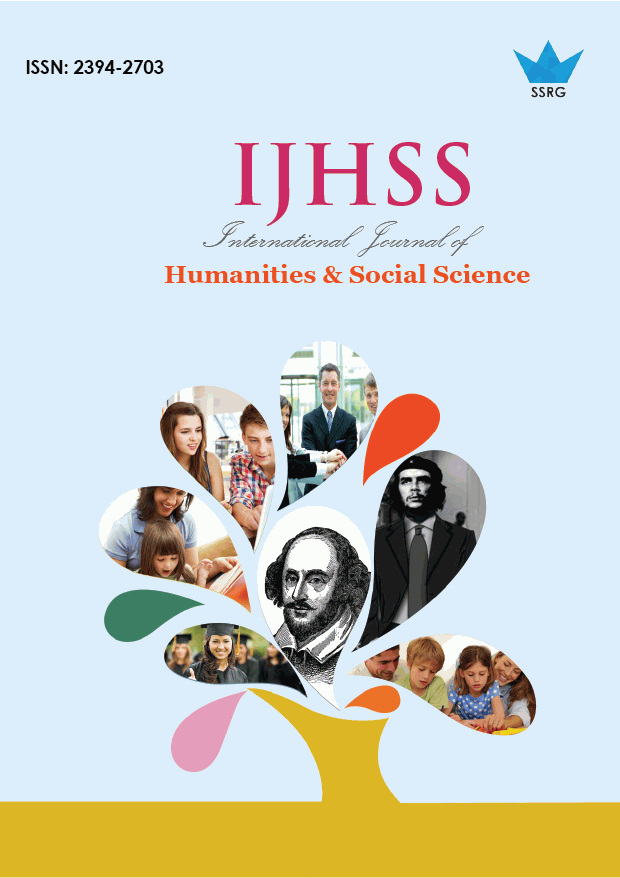Tradition, Modernity, and the Female Body: A Critical Study of the Kumari Tradition in Nepal

| International Journal of Humanities and Social Science |
| © 2025 by SSRG - IJHSS Journal |
| Volume 12 Issue 2 |
| Year of Publication : 2025 |
| Authors : Priyanshi Poddar |
How to Cite?
Priyanshi Poddar, "Tradition, Modernity, and the Female Body: A Critical Study of the Kumari Tradition in Nepal," SSRG International Journal of Humanities and Social Science, vol. 12, no. 2, pp. 60-71, 2025. Crossref, https://doi.org/10.14445/23942703/IJHSS-V12I2P107
Abstract:
Recently, international movements advocating for gender equality and children's rights have gained widespread support. Simultaneously, we find the existence of a centuries-old tradition of the Kumari in Nepal, where young girls are worshipped as living goddesses. The research paper examines the impact of the tradition on children and women across Nepal by investigating the social and cultural viewpoints and gender dynamics embedded within the tradition. Through detailed interviews and structured surveys conducted among citizens of Nepal, the paper explores personal beliefs, generational divides, and social attitudes toward the continuation of the tradition. The findings revealed a concern for the loss of childhood experiences faced by the Kumari, specially through an educational and social viewpoint. However, despite these concerts, a significant majority of the respondents supported the continued existence of the tradition, including acceptance and adherence to the 35 physical characteristics checked during selection. By analyzing these finances, the paper reveals how the Kumari tradition explored the complexities of the modern human rights framework while highlighting the tension between cultural preservation and the evolving discourse on children's rights and gender equality.
Keywords:
Kumari tradition, Women's rights, Cultural heritage, Child rights, Nepali tradition.
References:
[1] M.R. Allen, “The Cult of Kumari: Virgin worship in Nepal,” Institute of Nepal and Asian Studies, Tribhuvan University, 1975.
[Google Scholar] [Publisher Link]
[2] M.R. Allen, Kumari or ‘Virgin’ Worship in the Kathmandu Valley, Religions of the East, pp. 1-26, 2010.
[CrossRef] [Google Scholar] [Publisher Link]
[3] BBC Our World, Living Child Goddess in Nepal, Sahar Zand. [Online]. Available: https://www.youtube.com/watch?v=6-dLjePVK4E
[4] BBC World Service, Chosen to be a Kumari goddess - BBC World Service, Witness History. [Online]. Available: https://www.youtube.com/watch?v=RxLoFNt-r0k
[5] Footprint Adventure, Kumari: The Living Goddess of Nepal. [Online]. Available: https://www.footprintadventure.com/blog/living goddess-kumari
[6] David N. Gellner, Sondra L. Hausner, and Chiara Letizia, Religion, Secularism, and Ethnicity in Contemporary Nepal, Oxford University Press, pp. 1-512, 2020.
[Google Scholar] [Publisher Link]
[7] India Today, Living Goddesses of Nepal: The Enigmatic World of Child Kumari. [Online]. Available: https://www.youtube.com/watch?v=fqB2_2VZ-qE
[8] Journeyman Pictures, Nepal's Fascination with "Living Goddesses". [Online]. Available: https://www.youtube.com/watch?v=lxCbhJve6Ks
[9] Kathmandu Post, The Kumari Tradition Lives on, Balancing Ancient and Modern Values, 2017. [Online]. Available: https://kathmandupost.com/national/2024/08/01/the-kumari-tradition-lives-on-balancing-ancient-and-modern-values
[10] Chiara Letizia, “The Goddess Kumari at the Supreme Court: The Judiciary and The Debate on Religion and Secularism in Nepal,” Focaal, pp. 32-46, 2013.
[CrossRef] [Google Scholar] [Publisher Link]
[11] Chiara Letizia, “A State Goddess in the New Secular Nepal: Reflections on the Kumari Case at the Supreme Court,” Multiple Modernities and Postsecular Societies, pp. 115-141, 2016.
[CrossRef] [Google Scholar] [Publisher Link]
[12] Chiara Letizia, “Sacrifice, Violence, Resistance: Comments on Lecomte-Tilouine’s Handling of a Polyvalent Practice and Symbol,” European Bulletin of Himalayan Research, 2023.
[CrossRef] [Google Scholar] [Publisher Link]
[13] Understanding the Kumari, Inside the Himalayas, 2022. [Online]. Available: https://www.insidehimalayas.com/understanding-the kumari/
[14] John Mellowship, The Enchanted World of Kumari, Pilgrims Publishing, 2007.
[Google Scholar] [Publisher Link]
[15] National Geographic, Meet Nepal's Living Goddesses. [Online]. Available: https://www.nationalgeographic.com/magazine/article/nepal kumaris-kathmandu-valley
[16] Nepal Tourism Board, Living Goddess Kumari. [Online]. Available: https://ntb.gov.np/living-goddess-kumari
[17] NHK WORLD-JAPAN, Changing World of Nepal's Living Goddesses. [Online]. Available: https://www.youtube.com/watch?v=1P F6xkz09A
[18] Sangita Sigdel, “Living Goddess: Kumari Culture in Nepal,” SSRN Electronic Journal, 2021.
[CrossRef] [Google Scholar] [Publisher Link]
[19] Jai Ram Paudel, “Kumari Traditions: A Study on Performative Activity,” International Journal of Innovation Scientific Research and Review, vol. 4, no. 11, pp. 3580–3582, 2022.
[Google Scholar] [Publisher Link]
[20] Jeffrey Samuels et al., Figures of Buddhist modernity in Asia, University of Hawaii Press, 2016.
[Google Scholar] [Publisher Link]
[21] Durga Shakya, The Goddesses Tulaja and Kumari are Part of Nepali Culture, Kumari Publication, 2013.
[Publisher Link]
[22] Rashmila Shakya, and Scott Berry, From Goddess to Mortal: The True-life Story of a Former Royal Kumari, Vajra Publications, 2005.
[Google Scholar] [Publisher Link]
[23] Isabella Tree, The Living Goddess: A Journey into the Heart of Kathmandu, Eland, 2014.
[Google Scholar] [Publisher Link]

 10.14445/23942703/IJHSS-V12I2P107
10.14445/23942703/IJHSS-V12I2P107